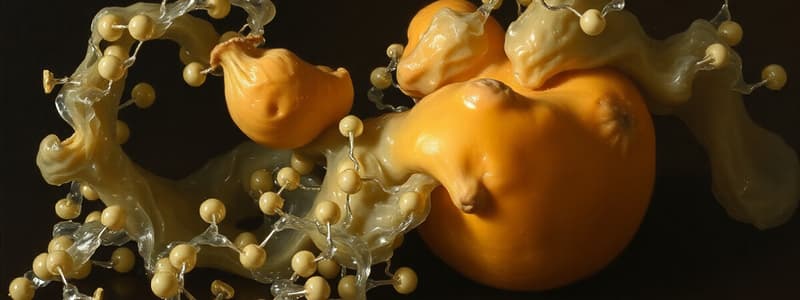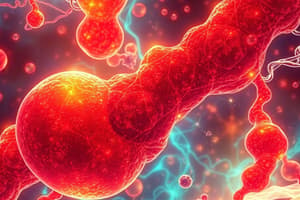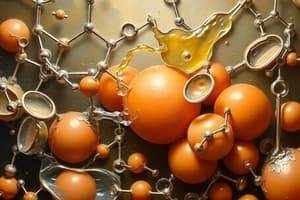Podcast
Questions and Answers
Why are fatty acids more efficient for energy storage compared to carbohydrates?
Why are fatty acids more efficient for energy storage compared to carbohydrates?
- Fatty acids have a lower molecular weight.
- Fatty acids are more reduced, allowing for greater energy release upon oxidation. (correct)
- Fatty acids contain more nitrogen atoms than carbohydrates.
- Fatty acids are readily hydrated, increasing their energy density.
What is the primary form of stored energy in the body?
What is the primary form of stored energy in the body?
- Triglycerides (correct)
- Glycogen
- Monosaccharides
- Amino acids
Which hormones trigger the release of fatty acids from adipose tissue?
Which hormones trigger the release of fatty acids from adipose tissue?
- Thyroxine, cortisol, and growth hormone.
- Prolactin, oxytocin, and vasopressin.
- Insulin, estrogen, and testosterone.
- Glucagon, epinephrine, and ACTH. (correct)
What is the function of pancreatic lipases in fat digestion?
What is the function of pancreatic lipases in fat digestion?
What is the role of carnitine in fatty acid metabolism?
What is the role of carnitine in fatty acid metabolism?
What is the end product of each cycle of β-oxidation?
What is the end product of each cycle of β-oxidation?
In the β-oxidation of fatty acids, what is the role of acyl-CoA dehydrogenase?
In the β-oxidation of fatty acids, what is the role of acyl-CoA dehydrogenase?
What is the function of enoyl-CoA hydratase in β-oxidation?
What is the function of enoyl-CoA hydratase in β-oxidation?
Which enzyme catalyzes the cleavage of β-ketoacyl-CoA during the last step of β-oxidation?
Which enzyme catalyzes the cleavage of β-ketoacyl-CoA during the last step of β-oxidation?
What is the primary role of the trifunctional protein complex in β-oxidation?
What is the primary role of the trifunctional protein complex in β-oxidation?
How many molecules of ATP are produced from the complete β-oxidation of one palmitic acid molecule?
How many molecules of ATP are produced from the complete β-oxidation of one palmitic acid molecule?
Why are fatty acids an important fuel source for migratory birds?
Why are fatty acids an important fuel source for migratory birds?
How does fatty acid oxidation contribute to metabolic water production in certain animals?
How does fatty acid oxidation contribute to metabolic water production in certain animals?
What is the end product of β-oxidation of odd-carbon fatty acids?
What is the end product of β-oxidation of odd-carbon fatty acids?
What cofactor is required for the conversion of propionyl-CoA to succinyl-CoA?
What cofactor is required for the conversion of propionyl-CoA to succinyl-CoA?
What is the role of enoyl-CoA isomerase in the oxidation of unsaturated fatty acids?
What is the role of enoyl-CoA isomerase in the oxidation of unsaturated fatty acids?
What enzyme is required for the degradation of polyunsaturated fatty acids, but not monounsaturated fatty acids?
What enzyme is required for the degradation of polyunsaturated fatty acids, but not monounsaturated fatty acids?
How does peroxisomal β-oxidation differ from mitochondrial β-oxidation?
How does peroxisomal β-oxidation differ from mitochondrial β-oxidation?
What is α-oxidation?
What is α-oxidation?
Which enzyme is deficient in Refsum's disease?
Which enzyme is deficient in Refsum's disease?
What are ketone bodies?
What are ketone bodies?
What conditions typically lead to increased production of ketone bodies?
What conditions typically lead to increased production of ketone bodies?
What is the significance of detecting acetone on the breath of individuals with type I diabetes?
What is the significance of detecting acetone on the breath of individuals with type I diabetes?
How do ketone bodies contribute to acidosis?
How do ketone bodies contribute to acidosis?
What is the initial step in how glucagon, epinephrine and ACTH trigger the release of fatty acids from adipose tissue?
What is the initial step in how glucagon, epinephrine and ACTH trigger the release of fatty acids from adipose tissue?
After fatty acids are released from adipose tissue, how are they transported in the blood?
After fatty acids are released from adipose tissue, how are they transported in the blood?
In the context of fatty acid catabolism, what does the term 'activation' refer to?
In the context of fatty acid catabolism, what does the term 'activation' refer to?
What is the energetic cost of activating a fatty acid by attaching it to CoA?
What is the energetic cost of activating a fatty acid by attaching it to CoA?
Why is it necessary to convert long-chain fatty acids to acyl-carnitines before they can be broken down?
Why is it necessary to convert long-chain fatty acids to acyl-carnitines before they can be broken down?
What is the role of the enzyme carnitine acyltransferase I?
What is the role of the enzyme carnitine acyltransferase I?
Which of the following is NOT a product of β-oxidation?
Which of the following is NOT a product of β-oxidation?
In the liver, what is the fate of acetyl-CoA produced from β-oxidation of fatty acids?
In the liver, what is the fate of acetyl-CoA produced from β-oxidation of fatty acids?
How can scientists measure catalytic power in an epimerase reaction, such as the one for methylmalonyl-CoA?
How can scientists measure catalytic power in an epimerase reaction, such as the one for methylmalonyl-CoA?
A mutation inhibits the Acyl-CoA dehydrogenase. What is the short term effect?
A mutation inhibits the Acyl-CoA dehydrogenase. What is the short term effect?
The concentration of hormone glucagon is increased. How does this influence fatty acid metabolism?
The concentration of hormone glucagon is increased. How does this influence fatty acid metabolism?
What is the function of lipoprotein lipase (LPL)?
What is the function of lipoprotein lipase (LPL)?
In the activation of fatty acids for beta-oxidation, what is the role of acyl-CoA synthetase?
In the activation of fatty acids for beta-oxidation, what is the role of acyl-CoA synthetase?
Why is carnitine necessary for fatty acid catabolism?
Why is carnitine necessary for fatty acid catabolism?
What is the sequence of reactions involved in each cycle of -oxidation?
What is the sequence of reactions involved in each cycle of -oxidation?
What role does the enzyme thiolase play in the -oxidation of fatty acids?
What role does the enzyme thiolase play in the -oxidation of fatty acids?
In the degradation of fatty acids, what is the significance of a trifunctional enzyme complex?
In the degradation of fatty acids, what is the significance of a trifunctional enzyme complex?
How does the energy yield from palmitic acid oxidation compare to that of carbohydrates or proteins?
How does the energy yield from palmitic acid oxidation compare to that of carbohydrates or proteins?
What is the metabolic advantage of animals, like migratory birds, storing energy as fats?
What is the metabolic advantage of animals, like migratory birds, storing energy as fats?
For animals that do not have ready access to drinking water, what role does fatty acid oxidation play?
For animals that do not have ready access to drinking water, what role does fatty acid oxidation play?
In the beta-oxidation of an odd-carbon fatty acid, what is the final product after the last cycle of beta-oxidation?
In the beta-oxidation of an odd-carbon fatty acid, what is the final product after the last cycle of beta-oxidation?
What is the role of vitamin B12 in the metabolism of odd-chain fatty acids?
What is the role of vitamin B12 in the metabolism of odd-chain fatty acids?
Why is enoyl-CoA isomerase required during the Beta-oxidation of unsaturated fatty acids?
Why is enoyl-CoA isomerase required during the Beta-oxidation of unsaturated fatty acids?
Which additional enzyme is specifically required for the beta-oxidation of polyunsaturated fatty acids, but not monounsaturated fatty acids?
Which additional enzyme is specifically required for the beta-oxidation of polyunsaturated fatty acids, but not monounsaturated fatty acids?
How does peroxisomal beta-oxidation differ fundamentally from mitochondrial beta-oxidation?
How does peroxisomal beta-oxidation differ fundamentally from mitochondrial beta-oxidation?
What is the most important characteristic of alpha-oxidation?
What is the most important characteristic of alpha-oxidation?
What is the underlying enzymatic deficiency in Refsum's disease that leads to the accumulation of phytanic acid?
What is the underlying enzymatic deficiency in Refsum's disease that leads to the accumulation of phytanic acid?
What is the metabolic origin of ketone bodies in the human body?
What is the metabolic origin of ketone bodies in the human body?
What conditions typically lead to an increase in ketone body production?
What conditions typically lead to an increase in ketone body production?
In individuals with type I diabetes, what is the primary mechanism by which excess ketone bodies contribute to acidosis?
In individuals with type I diabetes, what is the primary mechanism by which excess ketone bodies contribute to acidosis?
What is the fate of the glycerol produced in the adipose tissue upon triacylglycerol hydrolysis?
What is the fate of the glycerol produced in the adipose tissue upon triacylglycerol hydrolysis?
During fatty acid catabolism, how many ATP molecules (net) are generated per acetyl-CoA that enters the citric acid cycle (TCA)?
During fatty acid catabolism, how many ATP molecules (net) are generated per acetyl-CoA that enters the citric acid cycle (TCA)?
Flashcards
Fatty Acid Catabolism
Fatty Acid Catabolism
Fatty acids are catabolized to capture their inherent energy.
Carbon in Fatty Acids
Carbon in Fatty Acids
The carbon in fatty acids is highly reduced, allowing for greater energy release upon oxidation.
Hydration of Fatty Acids
Hydration of Fatty Acids
Fatty acids are not hydrated, so they pack more closely in storage tissues.
Triglycerides
Triglycerides
Signup and view all the flashcards
Hormonal Trigger
Hormonal Trigger
Signup and view all the flashcards
Triglyceride Breakdown
Triglyceride Breakdown
Signup and view all the flashcards
Fatty Acid Degradation
Fatty Acid Degradation
Signup and view all the flashcards
Mitochondrial Degradation
Mitochondrial Degradation
Signup and view all the flashcards
Acetyl-CoA Release
Acetyl-CoA Release
Signup and view all the flashcards
β-oxidation
β-oxidation
Signup and view all the flashcards
Acyl-CoA Synthetase
Acyl-CoA Synthetase
Signup and view all the flashcards
PPi Hydrolysis
PPi Hydrolysis
Signup and view all the flashcards
Carnitine Carrier
Carnitine Carrier
Signup and view all the flashcards
Acyl-Carnitine
Acyl-Carnitine
Signup and view all the flashcards
Creating Carbonyl Group
Creating Carbonyl Group
Signup and view all the flashcards
Products of β-oxidation
Products of β-oxidation
Signup and view all the flashcards
Electron Flow
Electron Flow
Signup and view all the flashcards
Enoyl-CoA Hydratase
Enoyl-CoA Hydratase
Signup and view all the flashcards
L-hydroxyacyl-CoA Dehydrogenase Oxidizes
L-hydroxyacyl-CoA Dehydrogenase Oxidizes
Signup and view all the flashcards
Aka B-ketothiolase attacks:
Aka B-ketothiolase attacks:
Signup and view all the flashcards
ATP Yield Palmitic Acid
ATP Yield Palmitic Acid
Signup and view all the flashcards
What does Palmitic acid Yield?
What does Palmitic acid Yield?
Signup and view all the flashcards
Migratory Bird Fuel
Migratory Bird Fuel
Signup and view all the flashcards
Energy + Water
Energy + Water
Signup and view all the flashcards
Fate of odd-carbon fatty acids
Fate of odd-carbon fatty acids
Signup and view all the flashcards
Enoyl-CoA isomerase
Enoyl-CoA isomerase
Signup and view all the flashcards
2,4-Dienoyl-CoA Use
2,4-Dienoyl-CoA Use
Signup and view all the flashcards
Peroxisomal Reaction
Peroxisomal Reaction
Signup and view all the flashcards
Chained Fatty Acids
Chained Fatty Acids
Signup and view all the flashcards
Ketone Bodies produced
Ketone Bodies produced
Signup and view all the flashcards
Synthesis Description
Synthesis Description
Signup and view all the flashcards
Cells Metabolism
Cells Metabolism
Signup and view all the flashcards
Study Notes
Fatty Acid Catabolism
- Fatty acids are catabolized, and their inherent energy is captured by organisms.
- Fatty acids are utilized by organisms for energy storage.
- Carbon in fatty acids is mostly -CH2- and reduced, allowing its oxidation to yield the most energy possible.
- Fatty acids are not hydrated like mono- and polysaccharides, which allows them to pack more closely in storage tissues.
Fats Mobilization
- Most "fats" in diet and adipose tissue are triglycerides.
- Triglycerides provide major energy input in the modern American diet.
- Triglycerides are the major form of stored energy in the body.
- Hormones like glucagon, epinephrine, and ACTH trigger the release of fatty acids from adipose tissue.
- Triglycerides occupy most of the volume of adipose cells.
Fat Digestion
- Pancreatic lipases and PLA2 break down TAGs.
- After absorption, they are reconstituted.
Fatty Acids Breakdown
- Knoop showed that fatty acids must be degraded by removing 2-C units.
- Albert Lehninger showed that this process occurs in the mitochondria.
- F. Lynen and E. Reichart showed that the 2-C unit released is acetyl-CoA, not free acetate.
- The process begins with oxidation of the carbon that is "β" to the carboxyl carbon, hence it is called "β-oxidation".
- Fatty acids are degraded by repeated cycles of oxidation at the β-carbon, with cleavage of the Cα-Cβ bond to yield acetate units in the form of acetyl-CoA.
CoA Activation
- Acyl-CoA synthetase condenses fatty acids with CoA, with simultaneous hydrolysis of ATP to AMP and PPi.
- Formation of a CoA ester is energetically expensive.
- Free energy change barely breaks even with ATP hydrolysis.
- Subsequent pyrophosphate (PPi) hydrolysis drives the reaction forward.
- The acyl-adenylate intermediate is present in the mechanism.
- Acyl-CoA synthetase activates fatty acids for β-oxidation.
- The reaction is driven by ATP hydrolysis to AMP and pyrophosphate, and by subsequent pyrophosphate hydrolysis.
- The acyl-CoA synthetase reaction involves fatty acid carboxylate attack on ATP, forming an acyl-adenylate intermediate.
- The fatty acyl-CoA thioester product is formed by CoA attack on this intermediate.
Carnitine as a Carrier
- Carnitine carries fatty acyl groups across mitochondrial membranes.
- Short-chain fatty acids are carried directly into the mitochondrial matrix.
- Long-chain fatty acids cannot be directly transported into the matrix.
- Long-chain FAs are converted to acyl-carnitines, and transported into the mitochondria.
- Acyl-CoA esters are formed inside the inner mitochondrial membrane from transported acylcarnitines.
β-Oxidation Reactions
- It is a repeated sequence of 4 reactions.
- The strategy is to create a carbonyl group at the β-C.
- The first 3 reactions create a carbonyl group at the β-C, the fourth cleaves the β-keto ester in a reverse Claisen condensation.
- Products are an acetyl-CoA and a fatty acid two carbons shorter.
- The first three reactions are crucial and classic, appearing again in other pathways.
- The β-oxidation of saturated fatty acids involves a cycle of four enzyme-catalyzed reactions.
Acyl-CoA Dehydrogenases
- Acyl-CoA dehydrogenases are a family of membrane-bound and soluble matrix enzymes.
- As a fatty acyl chain is shortened in successive β-oxidation cycles, it moves from the membrane-bound complex to the family of soluble matrix enzymes.
- Acyl-CoA dehydrogenase mechanism involves proton abstraction, followed by double-bond formation and hydride removal by FAD.
- Electrons are passed to an electron transfer flavoprotein (ETF), and then to the electron transport chain.
- Very long-chain fatty acids proceed through several β-oxidation cycles via membrane-bound enzymes in mitochondria.
- They proceed before becoming substrates for the separate soluble enzymes of β-oxidation.
- Two electrons are removed in the acyl-CoA dehydrogenase reaction are delivered to the electron transport chain in the form of reduced coenzyme Q (UQH2).
- The mechanism of acyl-CoA dehydrogenase is the removal of a proton from the α-carbon, followed by hydride transfer from the β-carbon to FAD.
Enoyl-CoA Hydratase
- Enoyl-CoA Hydratase adds water across the double bond.
- The addition of the elements of H2O across the new double bond is stereospecific, yielding corresponding L-hydoxyacyl-CoA.
- The reaction is catalyzed by enoyl-CoA hydratase, also called crotonase.
- These enzymes convert trans-enoyl-CoA derivatives to L-β-hydroxyacyl-CoA.
Hydroxyacyl-CoA Dehydrogenase
- L-Hydroxyacyl-CoA Dehydrogenase oxidizes the β-Hydroxyl Group.
- The third reaction of this cycle is the oxidation of the hydroxyl group at the β-position to produce a β-ketoacyl-CoA derivative.
- L-hydroxyacyl-CoA dehydrogenase, an enzyme that requires NAD+ as a coenzyme catalyzes
- NADH produced in this reaction represents metabolic energy.
- Each NADH produced by this reaction in mammalian mitochondria drives the synthesis of 2.7 ATP.
Thiolase
- Aka β-ketothiolase.
- Cysteine thiolate on the enzyme attacks the β-carbonyl group, leading to acetyl-CoA release.
- Thiol group of a new CoA attacks the shortened chain, forming a new acyl-CoA.
- This is the reverse of a Claisen condensation through attack of the enolate of acetyl-CoA on a thioester.
- The reaction is favorable and drives the other three reactions even though it forms a new thioester.
- Cys thiolate group attack at the β-carbonyl carbon produces a tetrahedral intermediate, decomposes with departure of acetyl-CoA, enzyme thioester intermediate.
- Attack by the thiol group of a second CoA yields a new acyl-CoA.
Trifunctional Protein Complex
- Oligomeric associations of constituent enzymes facilitate efficiencies for metabolic pathways.
- A trifunctional enzyme (TFE) is an important component of the β-oxidation pathway.
- Bacterial and human forms of this complex are similar with two types of subunits.
- The α-subunit contains the enoyl-CoA hydratase (ECH) and hydroxyacyl-CoA dehydratase (HCAD) activities
- The β-subunit contains the ketoacyl thiolase (KACT) activity.
- A substrate channel on the surface of the complex facilitates substrate channeling.
β-Oxidation Summary and Palmitic Acid Oxidation
- Repetition of the cycle gives a succession of acetate units.
- Palmitic acid yields eight acetyl-CoAs.
- Complete β-oxidation of one palmitic acid yields 106 molecules of ATP.
- Large energy yield results from highly reduced state of the carbon in fatty acids.
- Highly reduced state and low density makes fatty acids the fuel of choice for migratory birds and many other animals.
- Reduced Coenzymes drive synthesis of ATP in oxidative phosphorylation.
- Complete oxidation of palmitoyl-CoA yields a net of 106 ATP.
- 1 AcCo gives 10 ATP (in TCA, ETC).
- 1 NADH gives 2.5 ATP.
- 1 FADH2 gives 1.5 ATP.
- For an even FA with n carbons, n/2-1 beta oxidations, n/2-1(NADH + FADH2) and n/2 AcCoA.
- C16 gives 8AcCoA, 7(NADH +FADH2) – 2ATP invested to make initial CoAester.
Migratory Birds and Fatty Acid Oxidation
- Because they represent the most highly concentrated form of stored biological energy, fatty acids are the metabolic fuel of choice for sustaining the long flights of migratory birds.
- American golden plovers fly from Alaska to Hawaii nonstop – 3300 km in 35 hours – more than 250,000 wing beats.
- The ruby-throated hummingbird flies nonstop across the Gulf of Mexico
- These prodigious feats are accomplished by storing large amounts of triacylglycerols prior to flight.
- These birds are often 70% fat by weight when migration begins.
Metabolic Water and Fatty Acid Oxidation
- Large amounts of metabolic water are generated by β-oxidation.
- The oxidation of stored fatty acids can be a significant source of dietary water for certain animals, including desert animals (such as gerbils), killer whales (which do not drink seawater), and camels (whose hump is a large fat deposit).
- Metabolism of fatty acids from stores provides needed water and metabolic energy when drinking water is not available.
Odd-Carbon Fatty Acid Oxidation
- β-Oxidation of odd-carbon fatty acids yields propionyl-CoA.
- Odd-carbon fatty acids are metabolized normally, until a 3-C fragment - propionyl-CoA is reached.
- Three reactions convert propionyl-CoA to succinyl-CoA.
- Biotin and vitamin B12 involvement.
- Catalytic power of the epimerase reaction considered.
- Succinyl-CoA pathway for net oxidation considered.
- The conversion of propionyl-CoA (formed from β-oxidation of odd-carbon fatty acids) to succinyl-CoA is carried out by a trio of enzymes.
- Succinyl-CoA can enter the TCA cycle.
L-Methylmalonyl-CoA and B12 Catalysis
- L-Methylmalonyl-CoA catalyzed by B12 yields Succinyl-CoA.
- The methylmalonyl-CoA epimerase mechanism involves a resonance-stabilized carbanion at the α-position.
Unsaturated Fatty Acids Oxidation
- Consider monounsaturated fatty acids like oleic acid and palmitoleic acid.
- Proceed with normal β-oxidation for three cycles.
- Cis-Δ3 acyl-CoA cannot be utilized by acyl-CoA dehydrogenase.
- Enoyl-CoA isomerase converts this to trans-Δ2 acyl CoA.
- β-oxidation continues from this point.
- β-Oxidation of unsaturated fatty acids-in the case of oleoyl-CoA, three β-oxidation cycles produce three molecules of acetyl-CoA and leave cis-Δ3-dodecenoyl-CoA
- Enoyl-CoA isomerase rearranges this, giving the trans-Δ2 species, which then proceeds normally through the β-oxidation pathway.
Polyunsaturated Fatty Acids
- Degradation of polyunsaturated fatty acids is slightly more complicated.
- The process proceeds the same as for oleic acid, through 3 cycles of β-oxidation.
- Enoyl-CoA isomerase then converts the cis-Δ3 double bond to a trans-Δ2 double bond.
- Permits 1 more round of β-oxidation.
- The resulting trans-Δ2, cis-Δ4 structure is a problem,
- 2,4-Dienoyl-CoA reductase solves this problem.
- Polyunsaturated FA use beta oxidations until the first C=C bond is reached, where enoyl-CoA-isomerase makes the trans delta 2 unsaturated ester and beta oxidation continues until the second double bond is reached
- 2,4-Acyl-CoA dehydrogenase uses NADPH to reduce the ends to a single C=C.
Peroxisomal β-Oxidation
- Peroxisomes are organelles with flavin-dependent oxidations, with oxidized flavins regenerating by reaction with O2 to produce H2O2.
- Similar to mitochondrial β-oxidation, but initial double bond formation is by acyl-CoA oxidase.
- Electrons go directly to O2 from the flavoprotein, and there is no electron transport.
- There are fewer ATPs.
- Requires FAD dependent acyl-CoA oxidase.
- Captured electrons used to make HOOH, needed for degradative processes (not available to ATP).
- Acyl-CoA requires FAD-dependent acyl-CoA oxidase.
Branched-Chain Fatty Acids and α-Oxidation
- α-Oxidation is required as an alternative to β-oxidation
- Branched chain FA with branches with odd-number carbons are not good substrates for β oxidation and are alternatives in this instance.
- Phytanic acid α-oxidase decarboxylates with oxidation at the alpha position.
- β-oxidation past branch.
- Branched-chain FA are oxidized by α-oxidation- product is suitable for normal β-oxidation Isoputiryl-CoA and propionyl-CoA can both be converted to Succinyl-CoA, and can enter the CAC.
- Refsum’s disease results from the mitochondrial α-oxidizing Enzyme.
Refsum’s disease
- Rare inherited disorder-patients lack mitochondrial α-oxidizing e.
- Consequence large quantities phytanic acid in tissue and serum
- Cerebellar ataxia (lack of muscle control), retinitis pigmentosa (genetic disorder eyes), nerve deafness peripheral neuropathy
- Restriction dairy products, ruminant meat alleviate symptoms.
ω-Oxidation
- Yields small amounts dicarboxylic acids.
- Dicarboxylic acids are a form by oxidation of the omega carbon of fatty acids (Cytochrome P-450 dependent reaction).
Ketone Bodies
- Special source to tissues.
- Acetyl-CoA from fatty acid oxidation -> Acetone Acetoacetate, α-hydroxybutyrate.
- Source fuel brain heart muscle.
- Transportable Fa.
Ketone Metabolism, Synthesis
- Synthesis ketone bodies only mitochondrial matrix
- Figure 23.26 reverse Thiolase
- Second reaction HMG-CoA
- Mitochondrial analogs of first two Cholesterol Synthesis Third HMG-CoA lyase same Citrate Synthase.
Ketone Bodies & Diabetes
- "Starvation" Cell plenty glucose abound blood, uptakes cells low
- Cells metabolically starved turns gluconeogenesis fat protein catabolism
- Diabetic OAA (oxaloacetic acid) - Low excess gluconeogenesis acetyl-CoA (catabolism/protein) does not go into CAC = Ketone production
- Acetone detected breathe
Ketone Bodies & Acidosis
- Relativley strong acids (Pka ~3.5) lower the pH
- Impairs ability hemoglobin to bind oxygen.
Studying That Suits You
Use AI to generate personalized quizzes and flashcards to suit your learning preferences.




